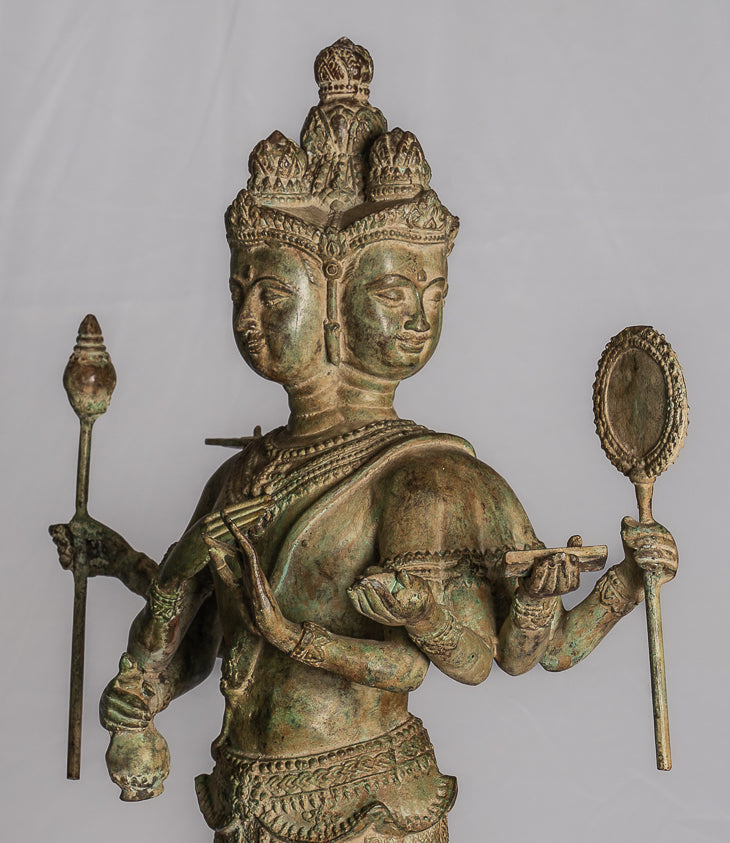-
Nandi and Shiva - Antique Javanese Style Majapahit Shiva and Nandi Statue - 40cm/16"
Measures - (Height) 40cm/16"
An antique Majapahit style bronze Shiva seated on his mount or vahanas Nandi.
One of the most famous and enduring relationships in Hindu iconography is that of the god Shiva and his mount, Nandi the bull.
This sacred connection between the two not only reflects the unique qualities of both Shiva and Nandi but also holds deep symbolic meanings that speak to devotion, strength, and the balance between the spiritual and material worlds.
Shiva is one of the most powerful and revered deities in Hinduism. He is part of the Hindu trinity (Trimurti), which includes Brahma the creator, Vishnu the preserver, and Shiva the destroyer or transformer. Shiva's role in the cosmic cycle is to destroy and dissolve, allowing for the renewal of the universe. This destructive aspect is not seen negatively; rather, it is essential for the process of creation and regeneration, maintaining the balance of the cosmos.
Shiva is often depicted as an ascetic yogi, meditating in the Himalayas, adorned with a crescent moon on his head, and holding a trident (trishul) and a drum (damru). He is also shown with a serpent coiled around his neck, signifying his control over life and death. Shiva's association with asceticism and meditation reflects his mastery over the physical and spiritual worlds, making him a god of paradoxes: both a destroyer and a creator, both a hermit and a householder, both fierce and gentle.
Nandi is a celestial bull and the vahana (mount) of Shiva. The name "Nandi" means "joy" or "bliss," and Nandi is considered a symbol of strength, loyalty, and auspiciousness. As the mount of Shiva, Nandi holds an elevated position in Hindu mythology, embodying several important qualities that complement Shiva’s nature.
The relationship between Shiva and Nandi goes beyond their mythological and iconographic depictions—it also carries deep spiritual significance. The pairing of the ascetic god Shiva and the powerful, loyal bull Nandi represents the balance between the spiritual and material worlds, the need for both inner strength and devotion, and the importance of selfless service.
The connection between Shiva and his mount Nandi is a profound and multi-layered symbol in Hinduism. Nandi is not just a mere vehicle for Shiva; he is a symbol of devotion, strength, and purity—qualities that complement and enhance Shiva’s transformative power.
Together, they represent the union of the transcendent and the material, the spiritual and the worldly, and the importance of both inner discipline and outer action on the spiritual journey.
In temples, in art, and in the hearts of millions of devotees, the relationship between Shiva and Nandi continues to inspire, teaching us the importance of devotion, loyalty, and strength in our own spiritual pursuits.
The divine bond between Shiva and Nandi remains a powerful reminder of the ideals that guide the Hindu path to liberation.
SATISFACTION GUARANTEE - We have been offering SE Asian Art for many years and are proud of the reputation we have developed for fair and honest listings. However, if for any reason, whatsoever, you are unhappy with your purchase please just let us know and we will provide a full refund. We want you to be 100% happy with your purchase.
-
The majority of orders will be shipped with DHL. This is a secure, express and fully tracked service.
Items less than 2Kg we typically ship using Royal Mail.
Once we receive your order we try to ship all orders the same or next working day.
Large and/or fragile pieces requiring palletising, specialist crating and/or extra packaging may take a little longer. Palletised shipments will be delivered curbside.
All orders over 35 GBP will be shipped free of charge.

-
We genuinely hope that all purchases delight.
However, if they do not, regardless of reason, we will refund all orders upon receipt of the unwanted item. Just notify us within 14 days of receiving your order that you wish to make a return and send the piece back to us with 30 days of delivery.
Hinduism’s origins and history reveal a tradition that is ancient yet ever-evolving, diverse yet unified in its spiritual essence.
It has shaped, and continues to shape, the cultural, philosophical, and religious landscape of India and the world.






























































